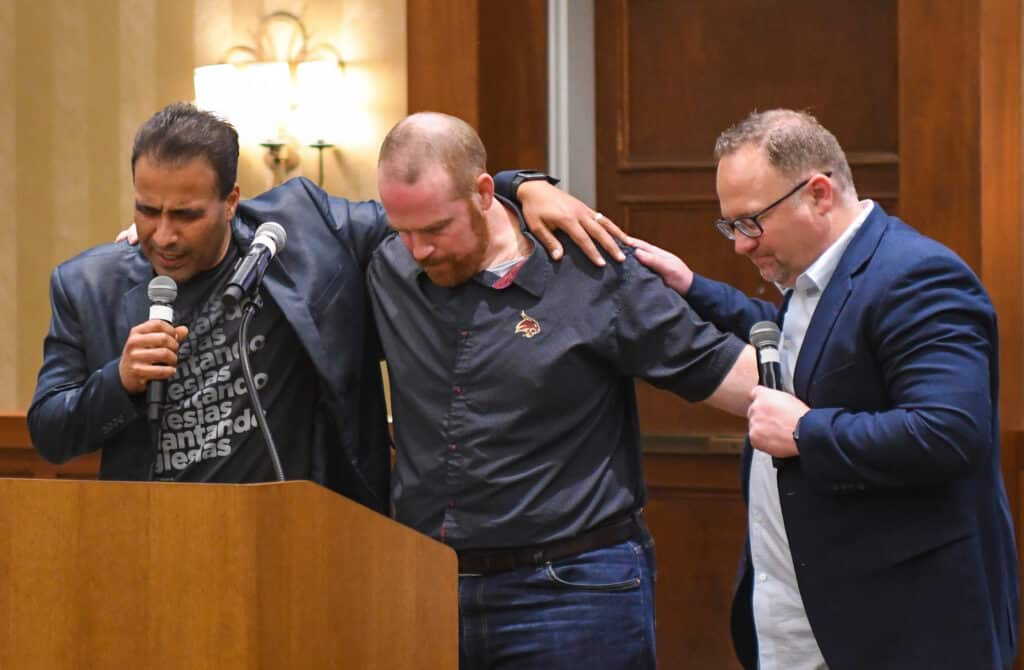|
Kenny Orr remembers as a small boy being allowed to turn off the main switch on the control panel that powered his church’s microphones. He would watch as the bulb slowly dimmed indicating that power to the two microphones?one in the pulpit and one for the Lord’s Supper?was indeed off. Today Orr works as a job supervisor for Ford Audio-Video, laying mile upon mile of microphone cables, connecting control panels to more than 100 microphones in just one church auditorium. Churches nationwide are going high-tech when building new worship areas or retrofitting existing buildings. The trend, in part, is an attempt to draw younger, more technology-savvy congregants into the worship service, Orr said. Others are doing it because it is now affordable. Some messengers to the Southern Baptists of Texas Convention annual meeting, held in October at Prestonwood Baptist in Plano, could have been overwhelmed by the facilities (the congregations of most SBTC churches could easily fit into the 580-seat choir rehearsal hall). What SBTC messengers did not see were the approximately 25 miles of microphone wire and 30 miles of speaker wire interwoven throughout the campus to connect 120 microphones to the control panel of the 7,000-seat auditorium. Gary Nicholson, an architect with LifeWay Christian Resources, said the move to add up-to-date audio-visual aids in the auditorium is not a fad but a purposeful trend. For many young non-believers, he said, the high-tech gadgetry is a draw. The reasoning seems to be churches no longer look like traditional churches and are, therefore, less intimidating or reminiscent of what the non-believers had been trying to avoid. Nicholson said all of the new high-tech capabilities in churches speak to a younger generation, projecting an image of being relevant. “Virtually all new sanctuaries I design have projection screens,” he said. Nicholson discussed the issue of cutting-edge technology being incorporated into new and existing church facilities while he and Doug Akers manned the LifeWay Christian Resources booth at the SBTC meeting. Akers works with Nichols as a customer relations representative for church architecture. Nicholson said his organization consults with audio-visual engineers when developing the architectural schematics for a church. For larger facilities such as Prestonwood, contractors will bid for media services work. Ford Audio-Video installed the Prestonwood sound system. In its project profile for the facility, Ford Audio-Video wrote that the auditorium was “designed with a theatrical/multimedia approach to services in mind. The church’s requirements for vocal presentations, musical performances, theatrical production and visiting artists demanded a high-power full-range system providing true, concert-quality sound.” The same company designed and built the audio, video, and theatrical lighting for Phase II of the Southwestern Baptist Theological Seminary’s Leadership Development Center. Some of the amenities in the new facility include an audio recording/editing suite, lighting control and theatrical system, document cameras, and an executive conference room featuring surround sound. Projection screens, Orr said, are much more affordable and durable and are often the first “high-tech” purchase a church will make. Pastors are using projection screens to illustrate sermons or post notes via Power Point. Ackers said what he has seen are taped testimonies shown on the screens while baptism candidates prepare for services. There is even a music production company releasing videos to go with musical tracks sold to choirs. And no longer is a choir merely lit by recessed canned lighting shining from overheads, giving the ensemble an angelic glow. Manually operated theatrical lighting or preprogrammed robotic lighting produce flashes of light timed with the music to add to the worship experience. For the techies who bring PDAs complete with uploaded Bibles to church, they can also watch a real-time or delayed webcast of the worship service?as they sit in the auditorium. Sunday school classrooms can even be wired for Internet to access interactive educational materials during lessons. Of the 75-100 church projects Orr’s company contracts each year, only 20 percent of the work is for new facilities. The remainder is for retrofitting existing structures. LifeWay’s Nicholson said when churches build a new facility, such as a new youth hall, they will contract to have the existing auditorium refitted with some of the latest in multi-media equipment.
Most Read
SBTC executive board hears reports on networks, church planting, and moreHORSESHOE BAY—There is power in connecting. That was a key message Spencer Plumlee, elder and senior pastor of First Baptist Church Mansfield, delivered to the Southern Baptists of Texas Convention executive board April 23 during its …
By
Jayson Larson
By
Jayson Larson
Explore more Southern Baptist news and history with us.Discover our online home of Texan Newsjournal editions from years past. 
Contact UsPO Box 1988 817-552-2500 Quick LinksCurrent Events. Relevant Topics. Gospel Stories.
Sections
Featured
|













